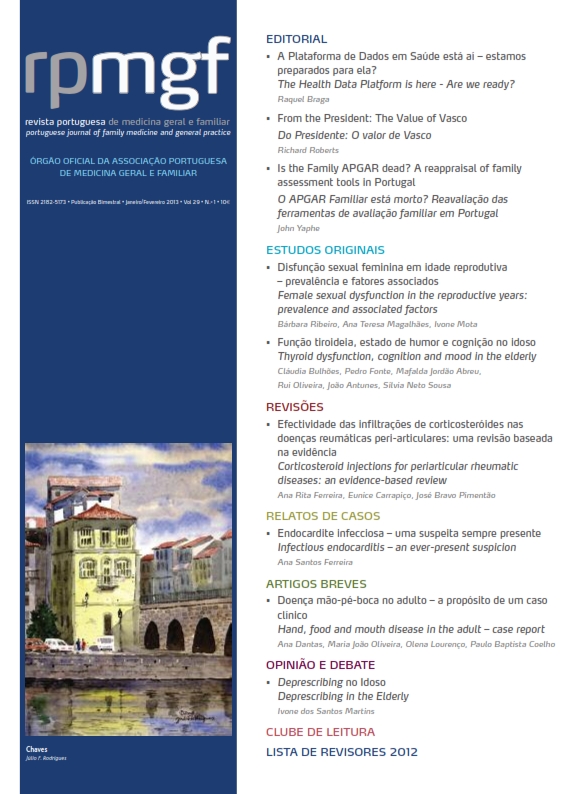Corticosteroid injections for periarticular rheumatic diseases: An evidence-based review
DOI:
https://doi.org/10.32385/rpmgf.v29i1.11046Keywords:
Injections, Corticosteroid, Effectiveness, Rheumatic Disease, PeriarthritisAbstract
Introduction: Periarticular rheumatic diseases are common and cause a significant economic and social burden. They are frequent causes of visits to family doctors. Corticosteroid injections are important adjuvants in the treatment of rheumatic diseases. They can be performed by doctors with the necessary skills. The aim of this paper is to review the evidence for the effectiveness of corticosteroid injections in seven common periarticular rheumatic diseases. Methodology:We selected seven common periarticular rheumatic diseases for review: carpal tunnel syndrome, epicondylitis, De Quervains disease, trigger finger, shoulder pain, trochanteric bursitis, and anserine bursitis. A systematic search for systematic reviews, randomized controlled trials and clinical guidelines was conducted for each condition. The searches were done in March 2011 for papers with the following eligibility criteria: (1) a population of patients diagnosed with one of the selected rheumatic diseases, (2) an intervention with corticosteroid injection versus no treatment, placebo or other treatments, (3) patient-oriented outcomes regarding effectiveness, (4) publication in or after 2000. We excluded studies not available in full text. Results: Thirty-six studies were included in this review. For carpal tunnel syndrome, corticosteroid injection was found to be more effective than placebo. Corticosteroid infiltration is also beneficial in reducing symptoms in the short-term for epicondylitis. In de Quervains disease, corticosteroid infiltration is recommended as the initial treatment. For trigger finger, infiltration is effective and safe compared to placebo. Is was not possible to make clear recommendations for corticosteroid injections for shoulder pain. For trochanteric bursitis, there is weak evidence for the use of infiltration. No eligible studies were found to evaluate the effectiveness of corticosteroid injection for anserine bursitis. Conclusion: The infiltration of corticosteroids steroids proved effective in treating four of the seven periarticular rheumatic diseases chosen for this review. There are considerable differences in the magnitude and duration of therapeutic effects in different conditions which makes it impossible to generalize regarding the effectiveness of corticosteroid injection for all periarticular rheumatic diseases.Downloads
Downloads
Published
Issue
Section
License
The authors will assign to the RPMGF the sole right to publish and distribute the content of the manuscript specified in this declaration via physical, electronic, broadcasting or any other medium that may come into existence. They also grant the RPMGF the right to use and exploit this manuscript, in particular by assigning, selling or licensing its content. This permission is permanent and takes effect from the moment the manuscript is submitted, has the maximum duration allowed by applicable Portuguese or international law and is of worldwide scope. The authors further declare that this assignment is made free of charge. If the RPMGF informs the authors that it is not going to publish their manuscript, the exclusive assignment of rights ceases forthwith.
The authors authorise the RPMGF (or any entity it may appoint) to act on their behalf when it believes that copyright may have been infringed.





